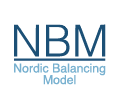Nordic aFRR CM Evaluation Report Reveals Insights on Cross-Zonal Capacity and Economic Surplus
The Nordic TSOs have completed the Evaluation Report for the Nordic aFRR capacity market covering analysis for the year 2023. The Evaluation Report covers the mandatory evaluation criteria set out in the methodology for the Nordic aFRR capacity market, which covers analysis on the accuracy of the forecast method, the utilization of cross-border capacity and an assessment of impacts on the economic surplus of both the SDAC and the exchange of balancing capacity from the application of the market-based allocation process.
Read the report: Evaluation report for 2023 for the Nordic aFRR market
Forecast Method for Cross-Zonal Capacity (CZC) Value
Regarding the forecast method for CZC values, it involves two components: a forecasted day-ahead market price spread and a dynamic markup. The forecasted price spread, derived from reference day prices (D-1), and the markup based on historical forecast errors are pivotal. Results indicate that while approximately 78% of combined borders and hours exhibit no errors, 12% of CZC costs are overestimated, and 10% fall below actual values.
10% NTC Limit for CZC
Concerning the 10% NTC limit for CZC, it efficiently allocates available CZC reserve across Nordic countries in most cases. However, some borders could benefit from higher capacity during specific hours, allowing more cost-effective bid selection. Despite the potential, TSOs utilized the option of increasing CZC limits for only a fraction of hours across three borders in 2023.
Impact on Economic Surplus
Lastly, the evaluation examines the impact on economic surplus, affecting both the single day-ahead coupling (SDAC) and the aFRR CM. While the SDAC experiences minor negative effects, the aFRR CM sees significant benefits. Producers in specific bidding zones benefit the most, albeit at the expense of negative consumer surplus. Different methods for calculating surplus reveal positive economic outcomes from balancing capacity exchange.
In conclusion, this comprehensive evaluation offers valuable insights for optimizing the Nordic aFRR CM and enhancing cross-border energy exchange efficiency.
